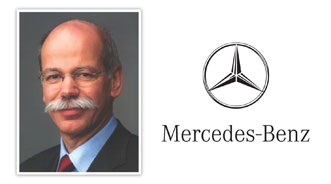Mercedes-Benz Eyes Return to Top of Luxury Market

By subscribing, you agree to receive communications from Auto Remarketing and our partners in accordance with our Privacy Policy. We may share your information with select partners and sponsors who may contact you about their products and services. You may unsubscribe at any time.
KECSKEMET, Hungary –
Daimler Auto Group believes Mercedes-Benz is well on its way to achieving the goals of its 2020 growth strategy and reclaiming the No. 1 position in the premium segment by the end of the decade.
Speaking to investors and analysts at the opening of the company’s new plant in Kecskemet, Hungary Thursday, Daimler chairman and the head of Mercedes-Benz Cars Dieter Zetsche declared, “Mercedes-Benz is consistently implementing its growth strategy. We have a fighting spirit in the entire organization to become the leading manufacturer of premium automobiles once again also in terms of unit sales.
“We are aware of the challenges, and we will master them,” Zetsche added.
To back up the top boss’ claims, the company mentioned this year is starting out well following success last year in which the division posted new records for unit sales, revenue and earnings.
Mercedes-Benz is expecting to report the best unit sales it has ever achieved in a first quarter.
With its Mercedes-Benz 2020 growth strategy, Mercedes-Benz reiterated that it intends to occupy the No. 1 position in the premium segment not only in terms of brand, products and profitability but also of unit sales.
Subscribe to Auto Remarketing to stay informed and stay ahead.
By subscribing, you agree to receive communications from Auto Remarketing and our partners in accordance with our Privacy Policy. We may share your information with select partners and sponsors who may contact you about their products and services. You may unsubscribe at any time.
Zetsche stressed efforts are being made to achieve those four goals thanks to the support of a large number of activities.
With regards to the Mercedes-Benz brand, Zetsche noted Daimler is further strengthening its core brand values of “fascination, perfection and responsibility” to broaden the customer base and address younger customers. He thinks this objective will be facilitated by the five new models of the new-generation compact car and also by vehicles such as the CLS Shooting Brake.
Furthermore, Daimler highlighted a third product offensive has been started with 10 new derivatives for which no predecessor models exist. This line is to be launched by the year 2015.
“For example, the luxury segment will be enlarged by expanding the S-Class range from three to six models with highly profitable derivatives,” Daimler pointed out.
Furthermore, Zetsche emphasized the planned activities also include further reductions in fuel consumption and CO2 emissions.
“We are convinced that ‘cool’ and ‘green’ can peacefully coexist in our garages,” Zetsche insisted.
The Daimler chairman added Mercedes-Benz models are being designed to reduce the average CO2 emissions of vehicles sold in the European Union from today’s 150 grams per kilometer to 125 g/km by the year 2016. Zetsche also said the new A-Class will start with emissions of 99 g/km.
Moreover in order to further increase unit sales, Daimler will boost its geographical presence by expanding sales structures and production capacities, especially in the NAFTA region and China.
Daimler cited forecasts that indicated worldwide vehicle sales will increase from 60 million units in 2011 to 100 million units in 2020. The company acknowledged China is already the world’s biggest market in terms of unit sales and will remain so in 2020, but the country’s car market will have doubled by then.
The company insisted China remains a cornerstone of Mercedes-Benz’s growth strategy, and the second-most important sales market, the United States, is projected to have an annual average growth rate in the premium segment of 5.6 percent.
Daimler also believes India will advance to become the world’s third-largest vehicle market by 2020.
Irrespective of this development, a clear target has been set of “achieving above-average growth in those markets and of further improving our competitive position," according to Zetsche.
In this context, he affirmed the medium-term target for unit sales of Mercedes-Benz: sales of more than 1.5 million vehicles in 2014 and more than 1.6 million in 2015.
Zetsche pointed out that the emphasis was on the word “more.”
He continued with, “Mercedes-Benz Cars will further improve its profitability by means of project-related cooperation such as with Renault/Nissan, as well as through savings achieved from the module and platform strategies and improved efficiency in the value chain. At the same time, the enhanced flexibility of the international production network will make it possible to react faster to fluctuations in demand.
“Due to savings from the module strategy and further efficiency actions, the division will be able to compensate for the cost burden anticipated in the automotive industry from rising raw-material prices and investments to reduce CO2 emissions, thus safeguarding its profitability targets,” Zetsche went on to say.
“At Mercedes-Benz Cars, we are approaching our targeted return on sales of 10 percent, which we want to achieve on a sustained basis as of 2013 — on the assumption that our business environment will remain stable,” Zetsche projected.
Zetsche wrapped up his discussion by reiterating how the Mercedes-Benz 2020 growth strategy works in practice can first be seen in the compact-car segment. He noted the new plant in Kecskemet is a “state-of-the-art” factory for Mercedes-Benz and will produce units in conjunction with the plant in Rastatt, Germany, and make a key contribution to economy through volume flexibility.
The company chief also noted profitability in the compact-car segment will be additionally improved compared with the predecessor generation by producing a significantly higher volume of five different cars from the same architecture instead of two and by spreading the production network over three plants: Rastatt, Germany, Kecskemet, Hungary and Beijing.


